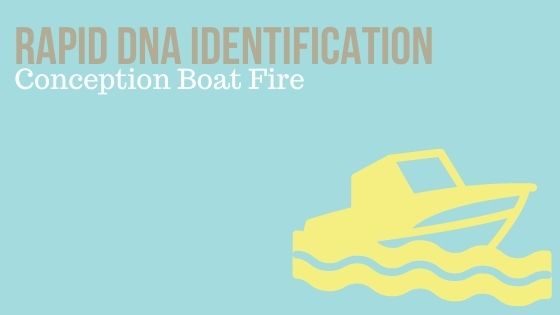In the early morning hours of September 2, 2019, a fire started in Santa Barbara County, just off the coast of Santa Cruz Island, on the Conception Dive boat with 39 passengers and crew on board. Five crew members were rescued and the remaining crew member and passengers located below deck when the fire started were unaccounted for and presumed deceased. Search and rescue operations quickly turned to search and recovery efforts as the first set of victims were recovered. Santa Barbara County Sheriff’s Office requested assistance from Sacramento County Coroner’s Office in the form of identification via Rapid DNA.
On September 2, 2019, a Deputy Coroner and the Coroner drove down to Santa Barbara County with a Rapid DNA instrument and supplies to assist with identification. All 34 victims were recovered in 10 days’ time. Those same victims were identified by Rapid DNA in the same time frame with the final victim located and also identified on Day 10. All DNA processing of human remains and familial reference samples was performed by a single operator, and DNA results were obtained the same day samples were made available for testing.
During her presentation at ISHI 31, Kimberly Gin, Coroner at the Sacramento County Coroner’s Office outlined the identification process during this ten day period and demonstrated that Rapid DNA can be used routinely as the primary identification modality in mass casualty events. As there was not time for Kim to answer all of the questions that came in during the conference, we’ve compiled them here.
How did the boat fire start?
The cause of the fire is still unknown. There has been some speculation of possible ignition sources including a cell phone charging station, but the final ignition source is unknown.
How complete were the profiles given the conditions the bodies were found in? What was the quality of the DNA profiles obtained from the victims?
The STR profiles were almost all complete, with 24 loci for females and 27 for males—we used the FlexPlex assay. The bodies were badly burned and had been underwater for days—despite the poor condition of the bodies, the quality of the profiles was excellent.
Why was DNA selected for identification rather than other methods such as dental, FP or visual ID?
This was a decision made by the Riverside County Sheriff after hearing about the success in identifying the Camp Fire victims.
Based on our experience with the Camp Fire in late 2018, we found that Rapid DNA was the quickest identification modality. And that proved to be the case at the Conception Boat Fire as well—we had victim STR profiles typically the day of intake and made matches as soon as the family reference samples came in. We did use visual information in a small number of cases—for example, DNA results told us three of the victims were siblings. Investigators searched Facebook and noted that one of the siblings had a tattoo that matched one of the victims and the hair color of the other sibling plus a partial tattoo assisted with the identification of another victim. Eventually, the FBI came in with new fingerprint technology (for highly degraded fingerprints); they got results on 19 cases, all of which confirmed the Rapid DNA result.
When you’re obtaining family reference samples, how closely related does someone need to be to make an ID? Do you assign a statistical weight to that ID?
We do assign a statistical weight—based on the CRI (Cumulative Relationship Index). For parent-child and sibling-sibling relationships, we always ended up with probabilities well in excess of 99% (usually with several 9’s after the decimal). In the Camp Fire, we had avuncular relationships and grandparent-grandchild relationships that also led to identifications, but not in the Boat Fire—those were all parent-child or sibling-sibling.
Why is it that those 15 could not be identified using something other than Rapid DNA?
The bodies of those victims were not intact enough to use any other type of identification.
How does the equipment process the bone samples? Is there any pre-treatment done to them?
Yes, there is pre-treatment of bone samples. For relatively intact samples, the bone is crushed with a hammer and demineralized for a few minutes—then the material is run on an ANDE chip. For highly degraded samples, we do an overnight demineralization. More details can be found in:
Turingan, R.S. et al., 2020. Developmental Validation of the ANDE 6C System for Rapid DNA Analysis of Forensic Casework and DVI Samples. Journal of Forensic Sciences, 65(4), pp.1056–1071.
Turingan, R.S. et al., 2019. Identification of human remains using Rapid DNA analysis. International Journal of Legal Medicine, 63(3), p.173.
Were the comparisons of relatives and victims done manually or entered a database that made matches?
Yes, the victim and family reference samples were entered into a database for matching.
What was the approximate success rate that you obtained from running bone samples?
For relatively intact bone, in excess of 95%.
WOULD YOU LIKE TO SEE MORE ARTICLES LIKE THIS? SUBSCRIBE TO THE ISHI BLOG BELOW!
SUBSCRIBE NOW!


